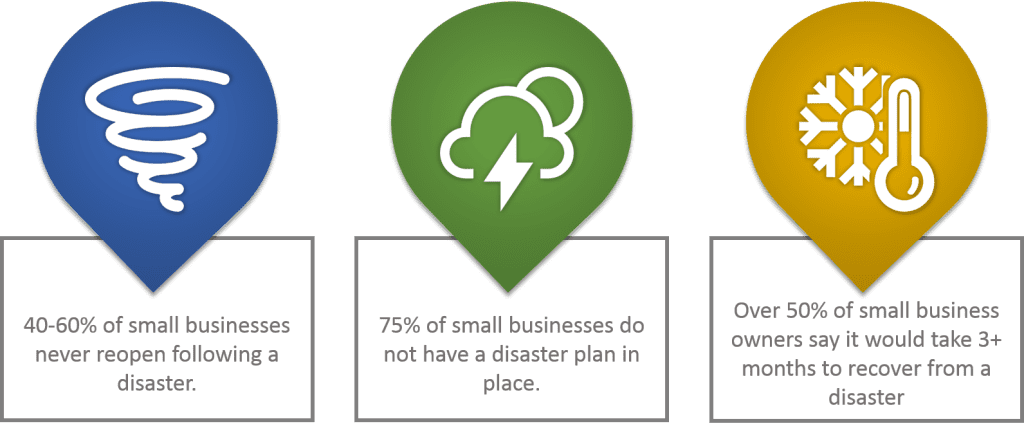Disaster Prevention: The Proactive Method To Protecting Your Cloud Solution

Understanding Why Disaster Prevention has to be part of your Cloud selection process.
Disaster comes in many forms, but is often the result of extreme weather, such as a flood or blizzard. Other disasters can be related to damage to your building, or damage to your electrical or internet services. Sometimes disaster is a viral outbreak, like the flu, stopping employees from coming in, or forcing everyone to work from home to avoid the illness spreading. In short, disaster is whatever arrives to disrupt your business from operating normally, or, in some cases from operating at all.
The impact from disaster varies, but the long term damage is loss of business. A lot of your business operations live in the cloud, which means that if it goes down, or if your employees aren’t able to access your cloud solution from different locations, your business won’t be able to function during or after the disaster. You may also struggle to get up and running again later due to loss of business, profit, and more. Could you survive 3+ months of business loss due to a disaster?

Protecting your business from disaster means ensuring your cloud solution works in the event of disaster. For some businesses that means you’ll be able to access all your data no matter where you are. For others it means that your customers can still get in touch with you, your employees can keep working, and that business can keep moving along in general.
One of the key value propositions of a cloud-based solution is that it should be resilient and protect you from disasters. This is critical because business ending disasters are becoming more and more common. But assuming just having a cloud service will protect you is not a good bet. Not all cloud services are created equal so you need to make sure that your cloud vendor includes Disaster Prevention as a Service in their offering.
Separating Disaster Prevention from Disaster Recovery
Disaster Prevention refers to the process and methodology your cloud provider puts in place to guarantee your cloud solution stays in service in the event of a disaster. Disaster Prevention should not be confused with Disaster Recovery. Disaster Prevention is proactive, as opposed to reacting and recovering your service after it has already failed with Disaster Recovery.
Disaster Prevention is different for every user. That’s because every user has different issues that need to be addressed, depending on what they use the cloud for, what features they use, their location, and their cloud requirements. That means that Disaster Prevention is really an umbrella service for making sure that your cloud solution works all the time, no matter what your unique cloud variables are. Disaster Prevention can be done through a variety of methods, like, architecting a solution that will solve issues that you may experience, providing a Service Level Agreement to ensure that you receive the service that you were promised, and delivering award-winning service and support if you do experience a problem.
If you’re using cloud for your communications solution, Disaster Prevention may refer to how your communications will continue to work. It also includes being architected to include features that allow you and your employees to use your communications system from any location.
Disaster Prevention Should Always Be Included In Your Cloud Solution
Disaster Prevention isn’t a solution that you need to purchase in addition to your cloud solution. It is a crucial piece that should always be included with any cloud solution. Without it the cloud can’t be complete or reliable. If your current or potential cloud provider doesn’t include Disaster Prevention, or only includes it as part of your package at additional cost, it is a huge red flag and you should re-evaluate your provider. Consistent and reliable service should be a given, and without Disaster Prevention you’re at risk for failure.
The Partnership Between Cloud and Disaster Prevention
A lot of companies move to the cloud so that their provider will be responsible for their cloud solution staying up in the event of a disaster. But, it can only stay up if your provider has set your system up for success and is following a Disaster Prevention plan. Cloud isn’t something that your provider can just turn on. They need to have all their ducks in a row to ensure success and that the system will always stay up and running. To make sure that it will support your business and work as promised, there are a handful of steps they need to keep and that you need to evaluate.
1 Does your provider complete a network assessment?
Network assessments review your entire communications infrastructure to provide a full view of what your network looks like. Network assessments help your provider identify issues that are likely to occur due to the way your network is set up. Then they architect a solution taking those issues into account and working around them, so that you never experience a problem.
The network assessment should occur at the very beginning of your relationship with your cloud provider, and even when you’re making significant changes to your communications platform. If your provider doesn’t perform a network assessment, or only devotes 5 or 10 minutes to the assessment, it’s a big red flag. To get a complete picture from your network assessment your provider has to dig in deep, which takes time.
2 Does your provider evaluate your last-mile connection?
All of your services rely on your last mile connection, including e-mail, web-browsing, cloud services, Wide-Area Network (WAN) connections to other voices, and Voice Over IP (VOIP). During your network assessment, your provider should always assess your last mile connection. If your area has low connectivity or has other issues relating to your last mile connection, your provider can utilize SD-WAN to guarantee that you have a reliable network. In a nutshell, SD-WAN uses multiple internet connections to guarantee that if one does fail you don’t lose service. In the event that your last mile connection fails, SD-WAN will roll your internet over to one of your other connections, so that your business can continue. Make sure your provider evaluates your last mile connection and has a plan in place to account for last mile issues.
3 How reliable is your cloud provider’s service?
When you’re reviewing your cloud provider’s reliability, you’re evaluating what infrastructure they have in place to guarantee that your solution doesn’t fail. As you know, cloud solutions are hosted in your provider’s data centers. So what happens when one of their data centers fails?
To guarantee reliability, your cloud provider should first have fail over servers within each of their data center. If one server fails, your service should automatically role over to another service without failing. Next, your cloud provider should have multiple data centers, geographically spread out. This will ensure that if an entire data center fails, your solution will roll over to a different data center, in a different area that isn’t impacted by whatever made the first center fail. You should also learn more about the failover process. Is it instantaneous? Or can you expect a few minutes of delay? And will only your voice application fail over? Or will your data roll over too?
Make sure your vendor also provides documentation on if and how they proactively monitor quality and uptime to ensure your service is working. Proactive monitoring ensures that if they detect something that they will be able to solve the issue, likely before you even realize it’s happened.
4 Are your applications covered in case of disaster?
You have all kinds of great applications, but what happens to them in the event of disaster? Will all of your applications fail over, or is part of your solution covered? For instance, if you are using cloud for your communications solution, will just voice fail over? Or will all of your other communications solutions, such as data, chat, and more roll over? If all of your communications applications are crucial to your business, you need to make sure that they all fail over. This same logic applies to any cloud solution you’re investing in.
If you’re using cloud for your communications solution, some applications can help you keep your business going in the event of a disaster. For instance, if you experience a site outage and your physical location is key to your business, there are a handful of solutions that your provider can implement as part of their Disaster Prevention offering to work around them, such as automated cell routing.Routing is something that can be added into the design of your phone system. In the event of a site outage, calls to your business will already be re-routed to pre-determined cell phones. When designed correctly, routing automatically happens.
Supporting Disaster Prevention with Quality Service
Disaster prevention isn’t complete unless it’s paired with quality service and support. Even the best systems can experience glitches and sometimes you need to make a change to your cloud solution. In either case, you can’t prevent disaster without a partner who is always there for you.
A lot of cloud providers claim that they provide best-in-class service and support, but that’s also something you need confirm. You need to make sure that your cloud provider has a clearly outlined support methodology. They need to have a support team that is large enough and in the right locations to support you. They should provide definitive emergency support and both onsite or remote support depending on your needs. And, in the event that something goes wrong, they should have a service request and escalation process.
Another good method to confirm your provider’s support is to look into their rankings with other companies. Have they been recognized for their support? Do they go out of their way to demonstrate their commitment and support? And what are their customers saying about them? Visit their website and see what their partners have said, what awards they’ve received, and what their customers have said to confirm that they are committed to support.
Guaranteeing the Cloud with Service Level Agreements
It’s one thing to assess your cloud provider for Disaster Prevention, but you also need to learn what policies your provider will put in place to make sure that they follow through with their promises. Some providers provide Service Level Agreements (SLA) to ensure that you receive the service that you were promised. An SLA is your service contract, and should clearly outline what you can expect in regards to your service, and what steps your cloud provider will take to guarantee your service.
Need Disaster Prevention?
In short, Disaster Prevention is unique to your exact needs but is crucial to the long term success of your communications system and business. If you already have a communications provider, but haven’t experienced the impact of disaster yet, you still have time. Reach out to your communications provider today to learn what their Disaster Prevention offering and make sure to evaluate the areas outlined in this article. If you have experienced a disaster, or your provider doesn’t deliver Disaster Prevention, Vertical can help. Disaster Prevention is part of every communications solution that we deliver, and we can back it up with a variety of Service Level Agreements.


